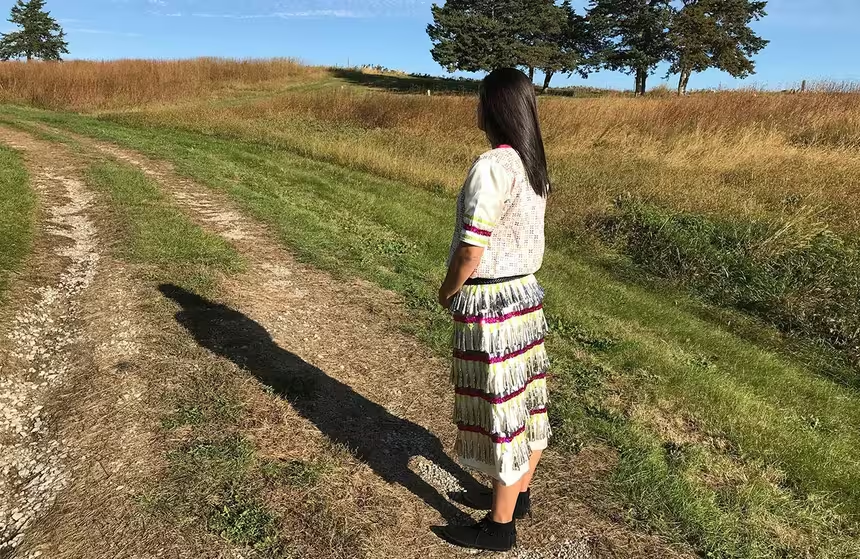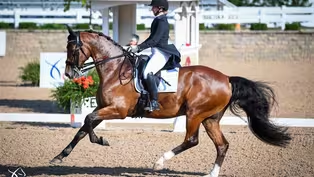
Thomas Naegle, Behind Barbed Wire
Clip: Season 15 Episode 1 | 11m 38sVideo has Closed Captions
German-born Artist Thomas Naegele paints images of life in a POW camp in Indianola, NE.
Artist Thomas Naegele, a German-born war refugee, entered another unexpected chapter in his young life when he was drafted into the U.S. Army during World War II. Thomas was assigned to Internment Camp Indianola in Nebraska, to serve as an interpreter. In his free time, he painted scenes depicting everyday life at the prison camp. Experience history through the eyes of this extraordinary artist.
Problems playing video? | Closed Captioning Feedback
Problems playing video? | Closed Captioning Feedback
Nebraska Stories is a local public television program presented by Nebraska Public Media

Thomas Naegle, Behind Barbed Wire
Clip: Season 15 Episode 1 | 11m 38sVideo has Closed Captions
Artist Thomas Naegele, a German-born war refugee, entered another unexpected chapter in his young life when he was drafted into the U.S. Army during World War II. Thomas was assigned to Internment Camp Indianola in Nebraska, to serve as an interpreter. In his free time, he painted scenes depicting everyday life at the prison camp. Experience history through the eyes of this extraordinary artist.
Problems playing video? | Closed Captioning Feedback
How to Watch Nebraska Stories
Nebraska Stories is available to stream on pbs.org and the free PBS App, available on iPhone, Apple TV, Android TV, Android smartphones, Amazon Fire TV, Amazon Fire Tablet, Roku, Samsung Smart TV, and Vizio.

Do you have a Nebraska Story?
Do you have a story that you think should be told on Nebraska Stories? Send an email with your story idea, your name, your city and an email address and/or phone number to nebraskastories@nebraskapublicmedia.org. Or, click the link below and submit your information on nebraskastories.org.Providing Support for PBS.org
Learn Moreabout PBS online sponsorship(gentle music) (gentle music) - [Narrator] In southwestern Nebraska in a tall grass meadow lie the scattered ruins of a prisoner of war camp constructed in World War II.
(gentle music) (gentle music) Broken concrete pads are all that remain of a place that once held German soldiers captured in North Africa.
(gentle music) (gentle music) (gentle music) The Nebraska Prairie Museum in Holdrege hosts an exhibit that preserves this remarkable period in Nebraska history.
-[Micah] I think majority of our guests say, "I never heard about this," and so I think it's a very unique moment in history that only lasted a couple years, but I think that most, the majority of people had zero idea that that event happened.
- [Narrator] During World War II more than 400,000 prisoners of war were confined in detention centers across America.
Nebraska hosted four base POW camps, each accommodating around 3000 prisoners.
The first arrived in 1943.
They were German and members of the Afrika Korps.
But, it's in the adjacent gallery where visitors can explore the everyday experiences of German POWs and their captors through paintings by Thomas Naegele.
(gentle music) (gentle music) -[Micah] So much of the photos that we have from the era are all black and white.
And so what he provided was atmosphere, color, perspective to the events of the camp.
(gentle music) (gentle music) (gentle music) (gentle music) - [Narrator] His mother a doctor, his father an artist, Thomas Naegele was born in Stuttgart, Germany in 1924.
- My mother was Jewish, she came from a Jewish family.
My father came from a protestant one.
- [Narrator] His childhood was a happy one until the Nazi Party rose to power.
In 1937, when he was 13, Thomas became a war refugee when he and his two brothers were shipped off to attend school in England.
-[Thomas] Well I said, I'm not goin', I'm staying in Germany.
My mother looked at me and said, "If you turn this down "there are lots of boys and girls "who will jump into your place instantly "and you'll go down in this country "and get lost and they will survive."
(gentle music) - [Narrator] His parents escaped Germany mere days before the war began.
The family reunited in England and then pushed on to North America, eventually settling in New York City where Thomas was able to finish high school before he was drafted into the United States Army.
(gentle music) - [Thomas] Officer at Fort Dix asked me a direct question.
He says, "How would you feel about firing on a German?"
I said, "I don't like the idea of firing on anybody, "but if I'm really confronted and it was "a question of survival, I would like to be the one "who pulls the trigger first."
(gentle music) So he rubbed his chin and says, "How about if we "put you in the medics?"
(gentle music) - [Narrator] As a German war refugee the Army struggled to find an occupation for Thomas.
He was reassigned to the Signal Corp to train as a lineman at Camp Crowder, Missouri.
It's where he had his first encounter with his former countrymen.
-[Thomas] Well one morning a question was asked at assembly, "Does anybody speak German?"
And I raised my hand, in spite of the advice that you should never volunteer for anything.
But, I was curious, and sure enough I was assigned to help relocate a building and the German crew arrived on a truck, under guard, and it was a very motley crew of different types whom I depicted there.
They were all from the Afrika Korps.
That was the first German Army unit to be incarcerated in America.
- [Narrator] Thomas underwent another duty change, but this one he kept for the duration of the war.
He was now an interpreter.
But, it was a role that caused other GIs to question his loyalty.
-[Thomas] This guy says, "What the hell is going on here?
"Are you a Nazi yourself?"
You know, they thought that I was with them.
(train horn) - [Narrator] Not long after the German POWs arrived in Nebraska, Thomas was stationed at Internment Camp Indianola, located about 10 miles east of McCook.
(train track sounds) - Believe it or not, I had my paint box from Germany and my school bag from Germany all the way through the Army.
(tires on gravel sounds) - [Narrator] On scraps of wood salvaged from junk piles Thomas began painting in his free time, recording a distinctive one-of-a-kind record of life behind barbed wire.
(static sounds) (indistinct chatter) -[Thomas] This is a sort of a catalog of the type of people as they arrived.
We had Navy personnel.
We had SS personnel.
We had elderly people.
(indistinct chatter) But, the tower was the obvious fundamental necessity for operating that camp.
And you could see that tower for miles around.
And of all things, it sprang a leak in the wintertime and ended up with a huge icicle cascade hanging overboard.
(hammering sounds) (horse and wagon sounds) They didn't like the bread that they had in the Mess Halls.
There were bakers among the PWs, so they actually were provided with flour that made decent bread.
(people bustling around) The Germans had discontinued the military salute and replaced it in their desperation with the Hitler salute.
And yet we Americans respected this order anyway.
I remember that McCook was crawling with officers from the nearby air base and it was customary to salute these people.
And they in turn, saluted back.
(city street sounds) - [Narrator] Thomas also captured a moment where he had to deal with angry prisoners rebelling over work detail.
(prisoners chatting) - I was supposed to take away the milk from their Mess Hall as a reprisal from us.
I unlocked the gate, which they were pressing on from behind.
The leader of that group was an S and S man.
His name was Post, and he sidled up to me in the Mess Hall and he says to me, "Naegele, do you know what we could do to you?"
(gentle music) I was the only American in that chorus of guys (gentle music) and I said to him, "Let me remind you, "you're in America and you're not gonna "get away with anything.
"And I advise you to control yourself and stand back."
And he did.
(gentle music) - [Narrator] Not all of the art on exhibit was created during Thomas's time in the service.
Several were painted five decades later to commemorate the 50th anniversary of World War II.
-[Thomas] I wanted to be part of that record.
I painted the pictures fairly quickly, one after another.
- [Narrator] The full set of paintings were exhibited on the east coast and then shown in Germany near Thomas's hometown.
It was while he was in Stuttgart that Thomas met Nebraskan, Glenn Thompson.
Thompson was writing a book on POW camps in America.
The men became friends and that is how the paintings found a permanent home in Holdrege.
-[Micah] Glenn had approached Naegele on the idea of having a POW exhibit space.
And so they somehow brokered a deal and they had built this prisoners of war interpretive center where we are in today.
(car door opening and closing) - [Narrator] In many respects Nebraska still retains the essence of the days when Thomas was stationed at Camp Indianola.
The relaxed, unpretentious way of life on the Great Plains left a lasting impression on him and he believes on the men who were once imprisoned here.
(gentle music) (horse neighing) (gentle music) - [Thomas] And rural America was in a sense, a cure.
(gentle music) You can't put it any other way.
But, the peacefulness of the middle west had a casual attitude towards life that made for an environment in which these prisoners got a whole different view of life (indistinct chatter) without realizing it.
(indistinct chatter) It wasn't organized.
It wasn't deliberately administered or anything.
It just co-existed.
(soft bustling sound) Overwhelmed all the trivia and the pettiness and selfishness and the racist attitudes, and the arrogance from which most of us, all of us, suffered to a certain extent.
(gentle music) Nature prevailed.
(birds chirping)
Video has Closed Captions
Clip: S15 Ep1 | 6m 26s | A mother and daughter compete together on the national stage in the sport of dressage. (6m 26s)
Providing Support for PBS.org
Learn Moreabout PBS online sponsorshipSupport for PBS provided by:
Nebraska Stories is a local public television program presented by Nebraska Public Media
















